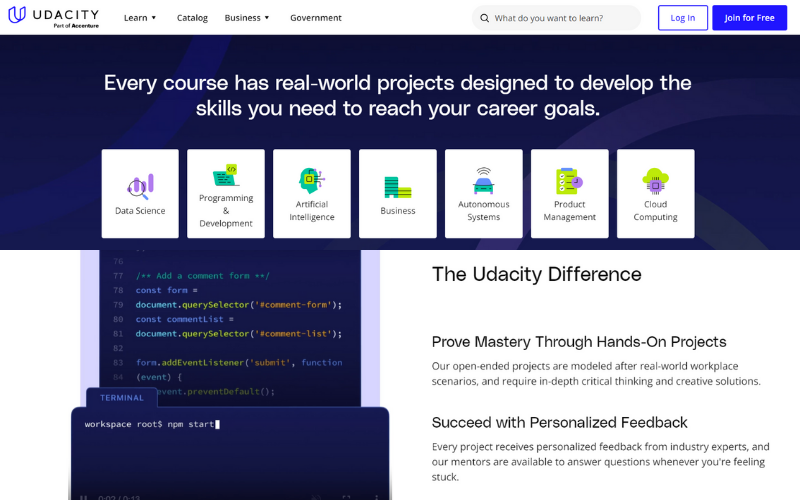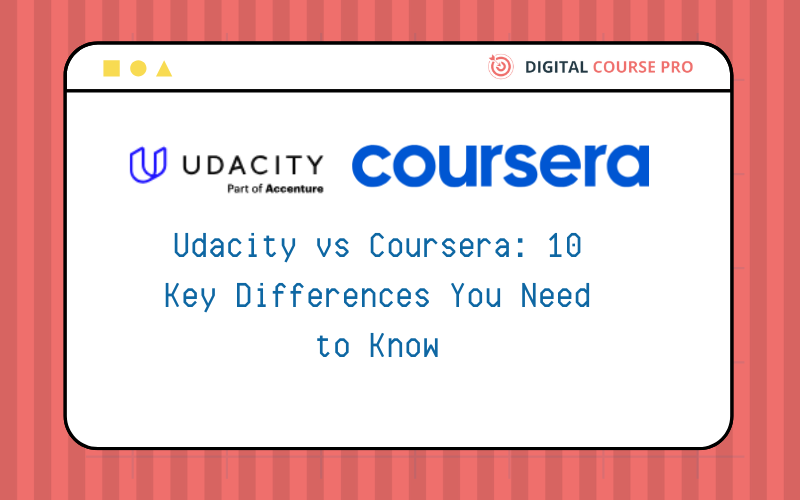When it comes to choosing an online learning platform, the debate of Udacity vs Coursera is a common one. Both platforms offer a variety of courses and programs to help you gain new skills and advance your career. However, they cater to different learning needs and preferences. In this detailed comparison, we will explore the key differences between Udacity vs Coursera, covering aspects like course offerings, teaching methods, certification value, pricing, and more.
1. Course Offerings
When it comes to Udacity vs Coursera, one of the most significant differences lies in their course offerings. Both platforms provide a wide range of educational content, but the focus, depth, and breadth of their courses vary considerably.
Udacity’s Course Offerings
Udacity specializes in technology and vocational training, emphasizing skills that are directly applicable in the workforce. Its course offerings include subjects such as:
- Artificial Intelligence (AI)
- Machine Learning
- Data Science
- Programming and Development
- Autonomous Systems
- Cloud Computing
- Cybersecurity
- Business Analytics
Udacity’s flagship programs are its Nanodegree programs. These are comprehensive, project-based courses designed in collaboration with industry leaders like Google, IBM, and Amazon. Each Nanodegree is structured to provide deep, specialized knowledge in specific fields, focusing heavily on practical, hands-on projects that simulate real-world tasks.
For example, the “AI for Healthcare Nanodegree” involves projects like developing deep learning models to improve patient diagnoses. Such projects ensure that learners not only understand theoretical concepts but also know how to apply them in practical scenarios. This project-centric approach is ideal for individuals aiming to build a robust portfolio of work to showcase their skills to potential employers.
Coursera’s Course Offerings
Coursera, on the other hand, offers a broader spectrum of subjects due to its partnerships with prestigious universities and institutions. These partnerships allow Coursera to provide courses that span a wide array of disciplines, including but not limited to:
- Arts and Humanities
- Business
- Computer Science
- Data Science
- Health and Medicine
- Information Technology
- Math and Logic
- Personal Development
- Physical Science and Engineering
- Social Sciences
- Language Learning
Coursera’s course offerings range from individual courses to comprehensive learning paths like Specializations, Professional Certificates, and full online degrees. Specializations consist of a series of related courses designed to build expertise in a specific subject area. Professional Certificates offer job-ready training and are often developed in collaboration with industry partners.
Coursera also provides access to full degree programs, which are accredited and recognized just like traditional on-campus degrees. For instance, the “Master of Computer Science” from the University of Illinois or the “Global MBA” from Macquarie University offer the same rigorous curriculum and credentials as their on-campus counterparts. This academic credibility is a significant advantage for learners seeking formal education and recognized qualifications.
Comparing Depth and Breadth
When comparing Udacity vs Coursera in terms of course depth and breadth, it becomes evident that:
- Depth of Udacity: Udacity’s courses are deep and specialized, focusing on technical skills required by the industry. The hands-on projects and industry collaboration ensure that the learners are job-ready.
- Breadth of Coursera: Coursera’s extensive range of subjects caters to a wider audience, from tech enthusiasts to those interested in arts, humanities, and social sciences. Its partnerships with top universities enhance the academic rigor and credibility of its offerings.
Course Structure and Delivery
Another aspect to consider in the Udacity vs Coursera debate is the structure and delivery of courses.
- Udacity: Courses are typically more intense and compact, designed to be completed within a few months. The focus is on self-paced learning with substantial support from mentors and a strong emphasis on project completion.
- Coursera: Courses vary in length, from a few weeks to several months, and often follow a structured schedule similar to university semesters. Learners can choose between self-paced courses and those with set schedules, including live sessions and peer interactions.
Practical Application vs Theoretical Knowledge
- Udacity: The practical, project-based approach of Udacity makes it ideal for learners who prefer to learn by doing and want to build a portfolio of real-world projects.
- Coursera: Coursera’s courses, especially those from academic institutions, often combine theoretical knowledge with practical applications. This balance makes it suitable for learners seeking a comprehensive understanding of a subject, including its theoretical foundations and practical implications.
Conclusion
In the Udacity vs Coursera comparison regarding course offerings, the choice largely depends on your learning objectives and preferences. If you seek specialized, tech-focused education with hands-on projects and direct industry application, Udacity might be the better choice. Conversely, if you are looking for a broad range of subjects, including formal academic education and recognized degrees, Coursera is likely the better option.
To delve deeper into what Coursera has to offer, especially if you’re considering online degrees and professional certificates, visit American Dream Academy on Coursera. This resource provides valuable insights and can help you make an informed decision in the Udacity vs Coursera debate.
2. Teaching Methods
When evaluating Udacity vs Coursera, one of the most critical aspects to consider is their teaching methods. Both platforms adopt distinct approaches to delivering educational content, catering to different learning styles and preferences.

Udacity’s Teaching Methods
Udacity’s teaching methods are centered around project-based learning and practical application. This approach is particularly effective for technical and vocational training, where hands-on experience is essential.
- Project-Based Learning: Udacity emphasizes learning through doing. Each Nanodegree program is structured around a series of real-world projects that students must complete. These projects are designed to mimic actual tasks professionals would encounter in the field. For example, in a data science Nanodegree, students might work on projects involving data cleaning, visualization, and building machine learning models. This project-based approach ensures that learners can apply theoretical knowledge in practical scenarios, making them job-ready.
- Industry Collaboration: Courses are developed in collaboration with leading tech companies such as Google, IBM, and Amazon. These industry partnerships ensure that the curriculum is up-to-date with current industry standards and that the skills taught are relevant and in-demand. This collaboration also provides learners with insights into what employers are looking for and prepares them for specific roles within these companies.
- Mentor Support: Udacity provides personalized mentor support to guide students through their courses. Mentors are industry professionals who offer feedback on projects, answer questions, and provide career advice. This support is crucial for maintaining motivation and ensuring that learners understand the material.
- Interactive Content: Udacity’s courses are highly interactive, featuring quizzes, coding exercises, and interactive simulations. This interactivity keeps learners engaged and helps reinforce their understanding of the material.
- Career Services: In addition to course content, Udacity offers career services, including resume reviews, LinkedIn profile optimization, and interview preparation. These services are designed to help students transition from learning to employment seamlessly.
Coursera’s Teaching Methods
Coursera’s teaching methods blend traditional academic approaches with modern online learning techniques. This combination makes Coursera suitable for a wide range of subjects and learners.
- Video Lectures: Coursera courses typically feature video lectures from professors and experts from top universities and institutions. These lectures are akin to attending a university class, providing learners with in-depth knowledge and insights from academic and industry leaders.
- Quizzes and Assignments: To reinforce learning, Coursera includes quizzes and assignments throughout its courses. These assessments help learners test their understanding of the material and provide a structured way to review key concepts.
- Peer-Reviewed Assignments: In many courses, especially those in the arts and humanities, assignments are peer-reviewed. This method allows learners to receive feedback from their peers, fostering a collaborative learning environment. Peer reviews also encourage critical thinking and engagement with the course content.
- Discussion Forums: Coursera courses include discussion forums where learners can interact with each other and the instructors. These forums facilitate knowledge sharing, networking, and collaborative problem-solving. They are particularly useful for clarifying doubts and discussing complex topics.
- Flexible Deadlines: Coursera offers courses with flexible deadlines, allowing learners to complete the coursework at their own pace. This flexibility is ideal for individuals balancing their studies with work or other commitments.
- Specializations and Guided Projects: Coursera’s Specializations consist of a series of related courses that build expertise in a specific area. Each Specialization culminates in a Capstone Project, which allows learners to apply what they’ve learned in a comprehensive final project. Guided Projects are shorter, hands-on experiences that teach specific skills through step-by-step instructions.
- Accredited Programs and Degrees: Coursera’s partnerships with universities allow it to offer accredited programs and full online degrees. These programs follow a traditional academic structure, including lectures, readings, assignments, and exams. The accreditation ensures that the credentials earned are recognized and valued by employers and academic institutions.
Comparing Teaching Methods: Udacity vs Coursera
When comparing Udacity vs Coursera in terms of teaching methods, it’s clear that both platforms offer distinct advantages based on the learner’s needs and preferences:
- Practical Application (Udacity): Udacity’s project-based learning and industry collaboration make it ideal for learners seeking practical, hands-on experience. This approach is particularly effective for technical subjects where skills need to be directly applied to real-world problems. The inclusion of mentor support and career services further enhances the learning experience and job readiness.
- Academic Rigor (Coursera): Coursera’s blend of traditional academic teaching methods with modern online tools makes it suitable for a broader range of subjects. The video lectures, quizzes, and assignments provide a structured learning experience akin to a university course. The addition of peer reviews and discussion forums fosters a collaborative and engaging learning environment. Coursera’s accredited programs and degrees add significant value for learners seeking formal education and recognized qualifications.
Conclusion
In the Udacity vs Coursera comparison of teaching methods, the right choice depends on your learning style and goals. If you prefer hands-on, project-based learning with a focus on technical skills and practical application, Udacity might be the better fit. However, if you value a more traditional academic approach with access to university-level courses and accredited programs, Coursera is likely the better option.
To explore more about Coursera’s offerings, especially if you are considering online degrees and professional certificates, visit American Dream Academy on Coursera. This resource provides valuable insights and can help you make an informed decision in the Udacity vs Coursera debate.
3. Certification and Accreditation
Certification value is a crucial aspect when comparing Udacity vs Coursera. Coursera certificates hold significant value due to its partnerships with reputable universities and institutions. Many of Coursera’s courses are part of larger degree programs and are recognized by employers. Coursera also offers accredited degrees and professional certificates. Udacity’s certificates, particularly its Nanodegree programs, are highly regarded in the tech industry. They are designed in collaboration with industry giants like Google, IBM, and Amazon, ensuring that the skills taught are relevant and in-demand.
4. Pricing and Financial Aid
Pricing is another key factor in the Udacity vs Coursera debate. Udacity’s Nanodegree programs can be quite expensive, with costs ranging from a few hundred to several thousand dollars. However, Udacity offers monthly payment plans and sometimes provides scholarships. Coursera offers a more flexible pricing structure, with many free courses available. For paid courses, Coursera offers financial aid to eligible learners, and its subscription model, Coursera Plus, provides unlimited access to thousands of courses for an annual fee. This makes Coursera a more affordable option for many learners.
5. Learning Flexibility
When comparing Udacity vs Coursera in terms of flexibility, both platforms offer self-paced learning options. Udacity’s courses are typically shorter and more intensive, requiring a significant time commitment over a few months. This format suits learners who prefer to complete their studies quickly. Coursera’s courses can vary in length, from a few weeks to several months, and are designed to fit around a learner’s schedule. Coursera’s flexible deadlines and the ability to audit courses for free provide additional flexibility for learners.
6. Instructor Quality
Instructor quality is high on both platforms, but the approach differs between Udacity vs Coursera. Udacity’s instructors are industry professionals who bring practical experience to their teaching. This real-world expertise is invaluable for technical subjects. Coursera’s instructors are often university professors and experts in their fields, providing academic rigor and depth. The presence of renowned educators from institutions like Stanford, Yale, and the University of Michigan enhances the credibility of Coursera’s courses.
7. Industry Connections and Career Services
In the Udacity vs Coursera comparison, industry connections play a significant role. Udacity has strong ties with tech companies and offers career services such as resume reviews, interview preparation, and job placement assistance. These services are particularly beneficial for learners looking to enter or advance in the tech industry. Coursera also provides career support through its Career Services and partnerships with companies for internships and job placements. However, its focus is broader, catering to various industries beyond tech.
8. User Experience and Platform Usability
The user experience of Udacity vs Coursera is another important consideration. Udacity’s platform is straightforward and easy to navigate, with a clean interface that focuses on course content and projects. Coursera’s platform offers a more comprehensive experience with additional features like discussion forums, peer reviews, and integration with LinkedIn for showcasing certificates. Both platforms provide mobile apps for learning on the go, but Coursera’s app is generally considered more robust.
9. Community and Peer Interaction
Community engagement is another differentiating factor in the Udacity vs Coursera debate. Coursera’s courses often include discussion forums where learners can interact, share ideas, and provide peer feedback. This community aspect is beneficial for collaborative learning and networking. Udacity, while not as strong in community interaction, offers mentor support and feedback on projects, ensuring personalized guidance throughout the learning process.
10. Special Features and Innovations
When looking at special features in Udacity vs Coursera, each platform has its unique innovations. Udacity’s Nanodegree programs are a standout feature, providing a structured and intensive learning experience. These programs are highly respected in the tech industry. Coursera’s special features include its partnerships with top universities, offering access to real university courses and the possibility to earn accredited degrees. Additionally, Coursera’s Coursera Plus subscription offers unlimited access to a vast library of courses, enhancing its value proposition.
Conclusion
In the debate of Udacity vs Coursera, the right choice depends on your learning goals, preferences, and budget. Udacity excels in providing industry-focused, project-based learning experiences that are particularly valuable in the tech sector. Coursera offers a broader range of subjects, academic partnerships, and flexibility, making it suitable for learners seeking both professional and personal development.
To gain a deeper understanding of Coursera and explore its unique offerings, especially for those considering online degrees and professional certificates, visit American Dream Academy on Coursera: 5 Powerful Benefits for Course Creators. This resource provides valuable insights and can help you make an informed decision in the Udacity vs Coursera debate.





